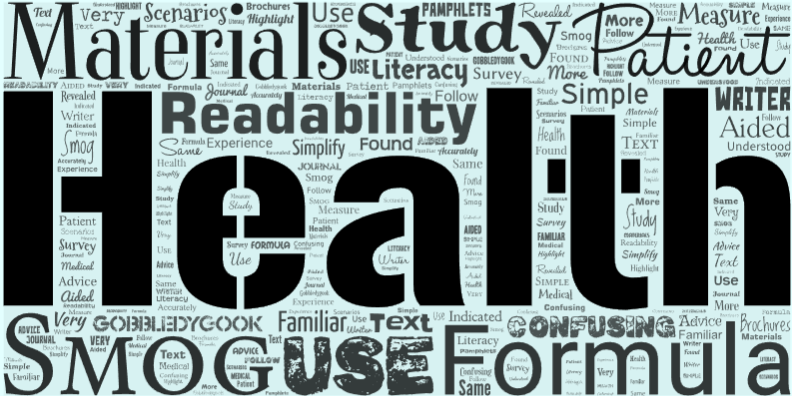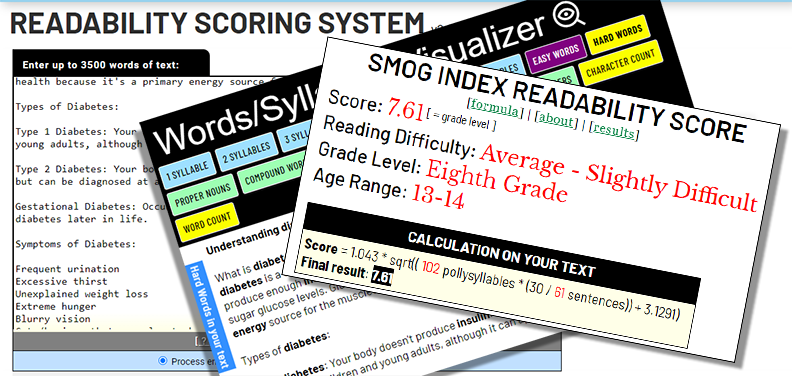When Jane received her medical prescription, she was puzzled. The instructions seemed complex and riddled with medical jargon. As she squinted at the words, she wished for clearer, simpler instructions. This is a struggle many people face.
Medicine often uses words that many people don’t understand. Doctors know words like “contraindications”, “subcutaneous”, and “titration”, but to people like Jane, they’re confusing. This confusion isn’t just about big words; it’s dangerous. Patients might take their medicine wrong, miss doctor’s appointments, or not follow their treatment plans because they don’t understand.
Readability formulas can give you the reading level of any text—the SMOG Readability Formula (Simple Measure of Gobbledygook) is a popular tool to use on health materials. SMOG doesn’t just measure text difficulty—it also reveals problem areas that make the text difficult.
Here are familiar scenarios where the SMOG formula aided the writer to simplify text in health materials:
Medication Leaflets:
- Original: “Patients should avoid the simultaneous intake of this drug with alcohol, as it may potentiate sedative effects.” Score: 11.57 [ = grade level ] | Reading Difficulty: Difficult | Grade Level: Twelfth Grade | Age Range: 17-18
- Simplified (after SMOG assessment): “Don’t take this medicine with alcohol. It can make you too sleepy.” Score: 6 [ = grade level ] | Reading Difficulty: Fairly Easy | Grade Level: Sixth Grade | Age Range: 11-12
Post-Operative Care Instructions:
- Original: “It is crucial to commence gentle mobility activities post-surgery to facilitate recovery and avert complications.” Score: 14.11 [ = grade level ] | Reading Difficulty: Professional | Grade Level: College | Age Range: 21-22
- Simplified: “After surgery, start moving around gently. It helps with healing and avoids problems.” Score: 4.44 [ = grade level ] | Reading Difficulty: Easy | Grade Level: Fourth Grade | Age Range: 9-10
Dietary Guidelines:
- Original: “Individuals striving for a balanced diet should consider incorporating a diversity of fruits and vegetables to ensure adequate nutrient intake.” Score: 15.23 [ = grade level ] | Reading Difficulty: Extremely Difficult | Grade Level: College Graduate | Age Range: 23+
- Simplified: “For a healthy diet, eat fruits and vegetables to get all the nutrients you need.” Score: 6 [ = grade level ] | Reading Difficulty: Fairly Easy | Grade Level: Sixth Grade | Age Range: 11-12
Exercise Recommendations:
- Original: “For optimal health benefits, individuals should contemplate engaging in brisk walking or similar exercises for intervals totaling 30 minutes daily.” Score: 17.24 [ = grade level ] | Reading Difficulty: Extremely Difficult | Grade Level: College Graduate | Age Range: 23+
- Simplified: “For good health, try brisk walking or similar exercises for about 30 minutes every day.” Score: 8.29 [ = grade level ] | Reading Difficulty: Average – Slightly Difficult | Grade Level: Eighth Grade | Age Range: 13-14
Disease Explanations:
- Original: “Diabetes is characterized by the body’s inability to regulate glucose levels effectively, necessitating external interventions.” Score: 16.26 [ = grade level ] | Reading Difficulty: Extremely Difficult | Grade Level: College Graduate | Age Range: 23+
- Simplified: “Diabetes means your body can’t control sugar levels well, so you might need treatment.” Score: 6 [ = grade level ] | Reading Difficulty: Fairly Easy | Grade Level: Sixth Grade | Age Range: 11-12
Vaccine Information:
- Original: “This vaccine introduces a harmless component of the virus into the body, prompting the immune system to develop a protective response.” Score: 11.57 [ = grade level ] | Reading Difficulty: Difficult | Grade Level: Twelfth Grade | Age Range: 17-18
- Simplified: “The vaccine gives your body a safe piece of the virus, so it learns how to protect you.” Score: 8.29 [ = grade level ] | Reading Difficulty: Average – Slightly Difficult | Grade Level: Eighth Grade | Age Range: 13-14
These examples show how the SMOG formula can help simplify technical health statements into more straightforward, accessible language.
Use our Readability Scoring System to score your text for you.
Health materials aren’t just a topic for researchers; they deeply affect our everyday lives. Let’s explore some eye-opening stats. These findings highlight that it’s not just about clear health information—it’s about saving lives. As the push for patient-centered care rises, crafting easy-to-understand health resources becomes more crucial than ever.
The Journal of Patient Experience (2018):
- Study: A survey of 1,200 patients revealed that 68% found health brochures and pamphlets either “confusing” or “very confusing.”
- Highlight: The same study also indicated that patients who understood the materials were 50% more likely to follow medical advice accurately.
Health Literacy Journal (2019):
- Study: A study of 2,500 adults showed that only 32% felt confident in their understanding of medical leaflets provided after doctor visits.
- Highlight: Among the respondents, those who felt they understood the materials exhibited a 60% higher adherence to medication schedules.
American Journal of Preventive Medicine (2020):
- Study: In a nationwide survey, 45% of adults stated they’ve either misinterpreted or misunderstood health guidelines in materials related to preventive care.
- Highlight: The survey stressed that comprehension was directly correlated to health outcomes. Patients who misunderstood materials were twice as likely to skip regular check-ups.
Global Health Communication Quarterly (2021):
- Study: In an international study spanning 10 countries, 58% of participants admitted to not fully understanding health brochures about common diseases like diabetes and hypertension.
- Highlight: This lack of understanding contributed to a 40% increase in avoidable hospital visits among the group.
Medical Communication Research (2017):
- Study Findings: In a focused study of elderly patients, a staggering 72% indicated difficulty in understanding health materials related to their medications.
- Highlight: Among this group, nearly 35% reported medication errors because their health materials were confusing.
Journal of Health Equity (2019):
- Study Findings: Examining health literacy among minority populations, the study found 62% of respondents felt that health materials weren’t culturally relevant or easy to comprehend.
- Highlight: Lower medical compliance rates among these populations reveals the need for culturally sensitive and clear materials.
International Journal of Pediatric Medicine (2020):
- Study Findings: A survey of parents and guardians of pediatric patients revealed 55% found health materials about their child’s conditions or treatments too confusing to follow.
- Highlight: Nearly 40% of respondents who didn’t understand the materials admitted to administering medications incorrectly to their children.
Health Information Technology Journal (2021):
- Study Findings: In a digital age study, 50% of adults expressed that while online health portals provided extensive information, their readability and user-friendliness were often lacking.
- Highlight: The study further noted that participants were 70% more likely to engage with health materials online if they were presented in layman’s terms with interactive visuals.
Journal of Rural Health Care (2022):
- Study Findings: In rural areas, where access to direct medical consultation can be limited, 64% of residents depended heavily on written health materials. However, 57% found these materials overly complex.
- Highlight: The research showed that simplified health materials could reduce primary care visits by 30%, saving costs and resources in rural settings.
World Health Communication Review (2022):
- Study Findings: In a global health literacy assessment, 53% of participants across various countries felt that health materials were too filled with medical jargon.
- Highlight: The study emphasized that even in regions with high education levels, the specificity of medical language can be a barrier, stressing universal simplification.
Pre-Existing Health Materials
Although creating materials from scratch for specific readability levels is easier, you may need to change existing materials. It’s not always about readability. New regulations, medical advice, or industry practices might require us to update existing content to stay accurate and compliant. Use the following guide to help you decide.







